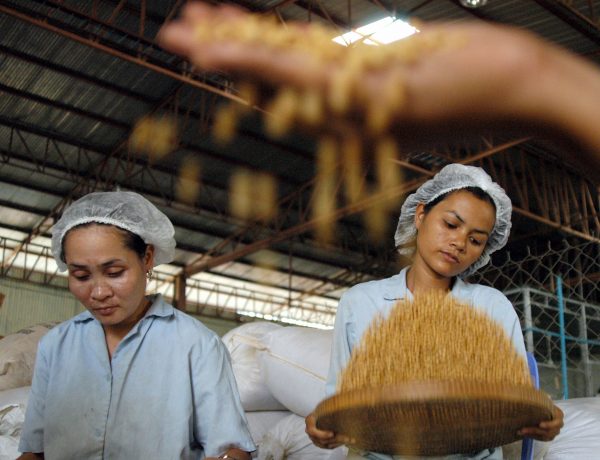SEZs are legal, logistical and tax arrangements intended to assist countries in attracting export-oriented manufacturing investment that would not happen without these zones. In developing countries, this may be because of poor domestic infrastructure, insecurity of investment, costly regulations or trade restrictions. The zones create favourable investment environments within a limited geographic area, but do not directly address problems outside them.
In 2014, total employment in Cambodia’s nine operational SEZs was around 68,000. SEZs represent just under 1 per cent of total employment and 3.7 per cent of total secondary industry employment in Cambodia. By comparison, Cambodia’s garments sector, mostly outside the SEZs, employed about 600,000 workers, about 38 per cent of total secondary industry employment, or ten times the size of all SEZs combined.
According to the economic literature, there are two criteria for assessing the ‘success and sustainability’ of SEZs. First, SEZs should address key constraints faced by investors in improving their firms’ competitive performance relative to the rest of the economy. Second, enterprises in SEZs should establish effective links with the rest of the economy to improve overall competitiveness, through supplier relations, transfers of technology, knowledge and by spurring policy reform.
Cambodia’s SEZs have so far not satisfied either criterion. But this does not mean they are failing. This is because both criteria are of limited relevance for a developing country like Cambodia.
The first criterion is about attracting the footloose, labour-intensive production in GVCs. Marginally improving the investment climate within the SEZ compared with the rest of the economy is not important. Rather, it is important that the environment within the SEZ is competitive compared with alternative international sites available to firms. If all the SEZ does is encourage firms already operating within the country to relocate to the zone, nothing significant has been achieved. If there are additional fiscal or other concessions provided within SEZs, this relocation could actually make the country worse off. Attracting new investment into the country and generating new employment, which would not exist in the absence of the SEZ, is what is required.
Also, Cambodia’s experience to date indicates that SEZ firms are not closely linked to the domestic economy. They are significantly less linked than similar firms operating outside the zones. But this does not mean that the zones are failing.
In a poor country like Cambodia, SEZs contribute primarily through employment creation, and they have the potential to increase this contribution. Even if the value-added per unit of output is small and is confined to the zones themselves, this can be important if the total volume of output is large.
The potential for labour-intensive manufacturing employment to expand within Cambodia is considerable, given the huge volume of GVC-related internationally footloose production that exists in the region. SEZs can provide employment at higher wages than unskilled workers can obtain in alternative employment, such as in agriculture, thereby substantially raising their welfare.
This is not in itself the answer to Cambodia’s long-term development problems. It is at best a temporary component of a package of policy measures designed to raise incomes, but it is valuable for the people concerned.
Even though SEZ firms so far have not been closely linked to domestic firms within Cambodia, SEZs may have a significant demonstration effect. SEZ firms can show that manufacturing investment beyond the garments sector can be successful, even though the trade preference-driven, labour-intensive garments industry currently dominates manufacturing in Cambodia. The development of SEZs may indirectly promote foreign direct investment outside the zones, though that will of course take time.
An interesting feature of the Cambodian SEZ policy is that the government has left the establishment and management of the zones to private sector developers. This allows Cambodia to avoid the large and sometimes wasteful public sector set-up costs associated with establishing SEZs in many other countries. It also introduces greater market discipline into the running and management of the SEZs, adding to their long-term viability.
SEZs as experimental sites for policy reform could be important for Cambodia, as they were in China during the late 1980s and early 1990s. The domestic policy measures needed to enhance the international competitiveness of the zones are similar to those needed in the rest of the economy.
To ensure the competitiveness of SEZs, the government must upgrade infrastructure to reduce transport costs. It must improve trade facilitation to reduce the costs and delays of importing and exporting. The cost and reliability of electricity supplies must also be improved. The government needs to reduce corruption and clarify the rules of payment to government agencies. The most important and most difficult reform for Cambodia is improving labour quality, starting with greater investment in basic literacy and numeracy. The experience of SEZs can help focus attention on these critical policy issues.
Professor Peter Warr is former head of the Arndt-Corden Department of Economics and director of the Poverty Research Centre at the Crawford School of Public Policy, The Australian National University.
Jayant Menon is a lead economist at the Economic Research and Regional Cooperation Department, Asian Development Bank (ADB) and an adjunct fellow at the Arndt-Corden Department of Economics, The Australian National University.
The full report upon which this article is based can be obtained here.

